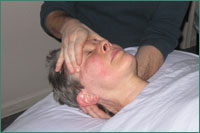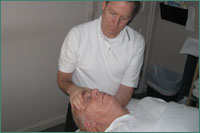Services Offered
What is Craniostructural Massage?

Over the last few decades, as people have continued to seek alternative ways to relieve pain and dysfunction in their bodies. Craniostructural Massage has developed a following. The technique is a marriage of basic Structural Integration Massage* with Cranial Mobilizations.
The therapist performs a thorough postural evaluation to discover distortions or positions of the body that depart from “normal” balanced posture and seeks pain patterns related to the distortions. Using basic muscle testing with challenges (gentle touch tests) to the cranial sutures (the gear-like joints of the skull) and joints of the body, the therapist discovers any compression of sutures or joint structures that are a result of or the cause of the postural distortions.
The examiner, gently holding the head with both hands, proceeds with a very gentle series of cranial, suture decompressions while maintaining a gentle twisting or torsioning of the head. This approach keeps continuous pressure on the membrane that wraps around the cranial bones and puts a gentle traction on the continuation of this membrane that wraps around the spinal cord (the dura mater). This membrane, otherwise called “fascia,” continues out from the spinal cord via the spinal nerves and wraps around every structure in the body…. all the nerves, blood vessels, internal organs, bones, muscles, lymph vessels etc.
 These gentle decompressions then actually have the potential of directly influencing every structure in the body. The potential end result is a gradual unwinding of soft tissue structures that are distant from the area of therapy (the head), and a gradual return towards structural balance. It’s been discovered that if the cranial work is done before the structural massage, associated, painful muscle symptoms will subside or cease. The massage work that follows the cranial work is a win-win as it is easier for the therapist and less painful for the patient.
These gentle decompressions then actually have the potential of directly influencing every structure in the body. The potential end result is a gradual unwinding of soft tissue structures that are distant from the area of therapy (the head), and a gradual return towards structural balance. It’s been discovered that if the cranial work is done before the structural massage, associated, painful muscle symptoms will subside or cease. The massage work that follows the cranial work is a win-win as it is easier for the therapist and less painful for the patient.
This kind of work requires repetition to break long standing postural habits in the body. A patient may have to commit to a series of appointments with a short interval between appointments to receive the full benefit of this approach to massage.
